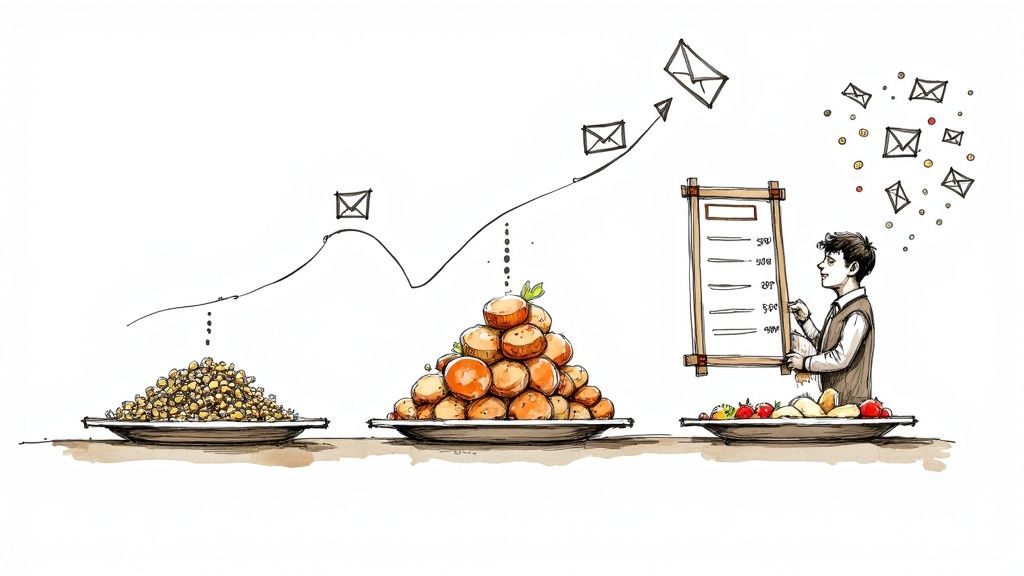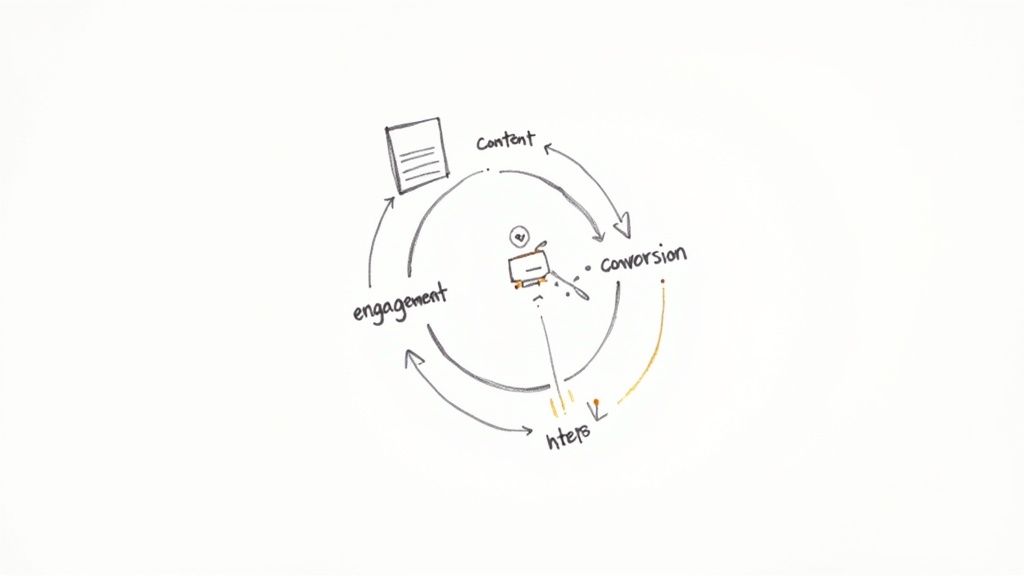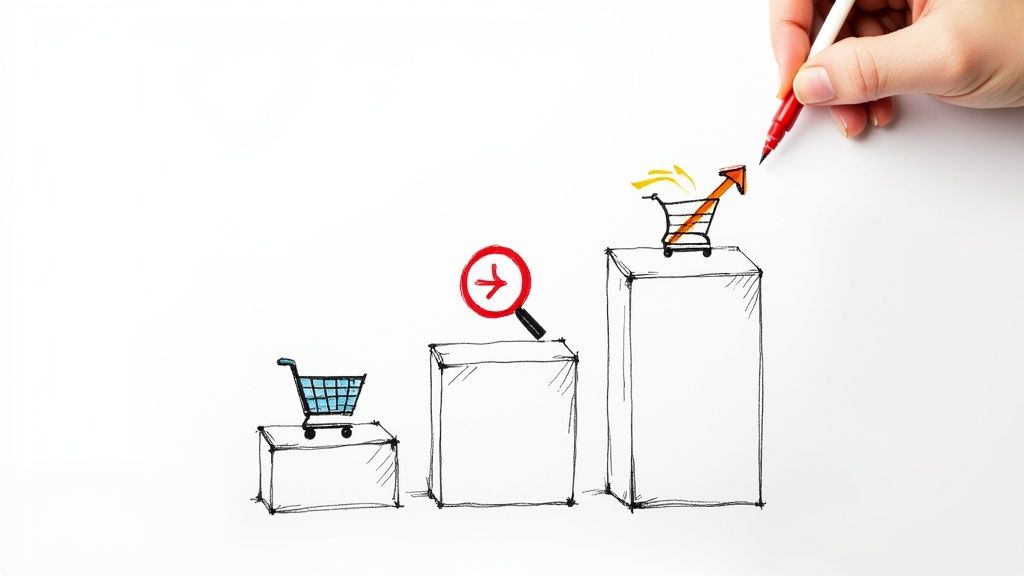Ecommerce Email Marketing Strategy That Actually Converts
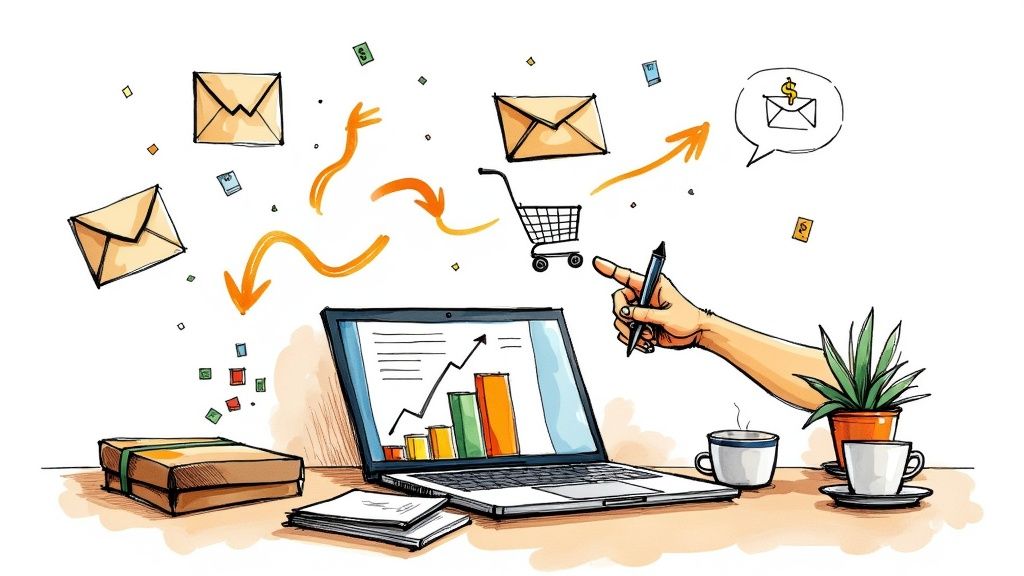
10 mins
6/21/2025
Joe Ervin
- ecommerce email marketing strategy
- email automation
- conversion optimization
- email segmentation
- customer retention
Why Smart Ecommerce Brands Bet Everything On Email
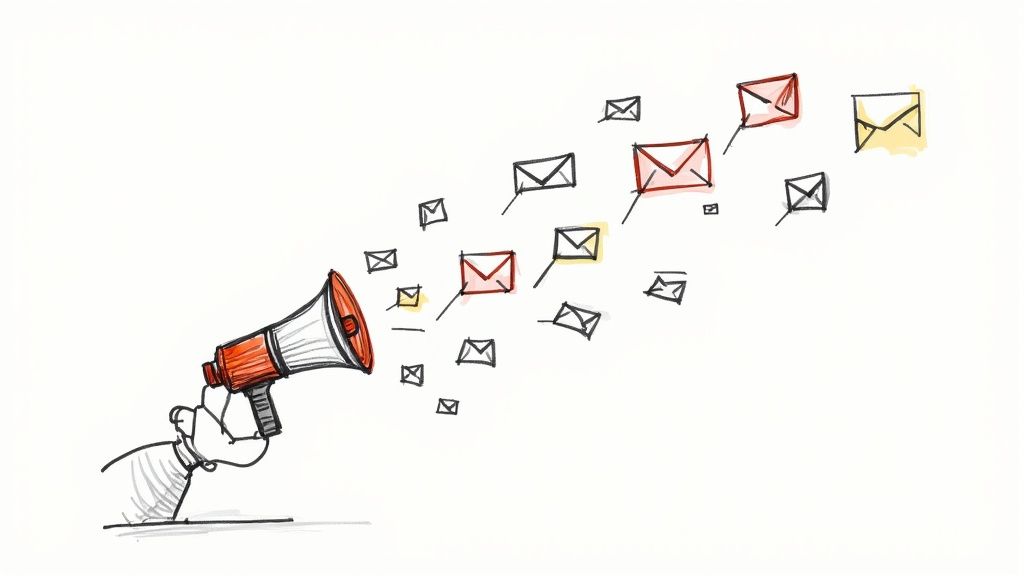
While many brands get caught up in the whirlwind of social media trends, seasoned ecommerce founders are quietly building their empires with email. Why the focus on the inbox? An ecommerce email marketing strategy isn't about gaming an algorithm; it's about building and owning a direct relationship with your audience. Your email list is a business asset you control, unlike social media followers who are tied to the platform.
This direct channel is one of the most dependable drivers for growth. When economic shifts make ad spending unpredictable, having a strong email list provides stability and a reliable way to reach your customers without paying for every interaction.
The Power of the Inbox
Think about your own email inbox. It's a personal and intentional space. When customers subscribe to your list, they've given you explicit permission to show up there. This creates a completely different relationship than one formed through a passing social media ad. They've opted in, which means they're already more open to what you have to say.
We've talked to numerous eight-figure brands that generate 40-60% of their total revenue from email alone. They don't just see it as a tool for promotions. For them, it's a primary channel for telling their brand story, offering genuine value, and building authentic connections with their community.
A Channel That Just Keeps Growing
The sheer number of people using email is massive and still climbing. In 2025, there will be an estimated 4.6 billion email users worldwide, sending and receiving over 376 billion emails every day. This isn't just a big audience; it's an engaged one.
Here’s why that matters for your brand:
- A solid 60% of consumers say they prefer to receive brand communications through email.
- With 88% of people checking their inbox multiple times a day, your messages have a high chance of being seen and opened.
These numbers show exactly why a focused ecommerce email marketing strategy is a top priority for businesses looking for long-term, sustainable success. You can dive deeper into these powerful email statistics on designmodo.com.
The ROI Numbers That Make CFOs Pay Attention
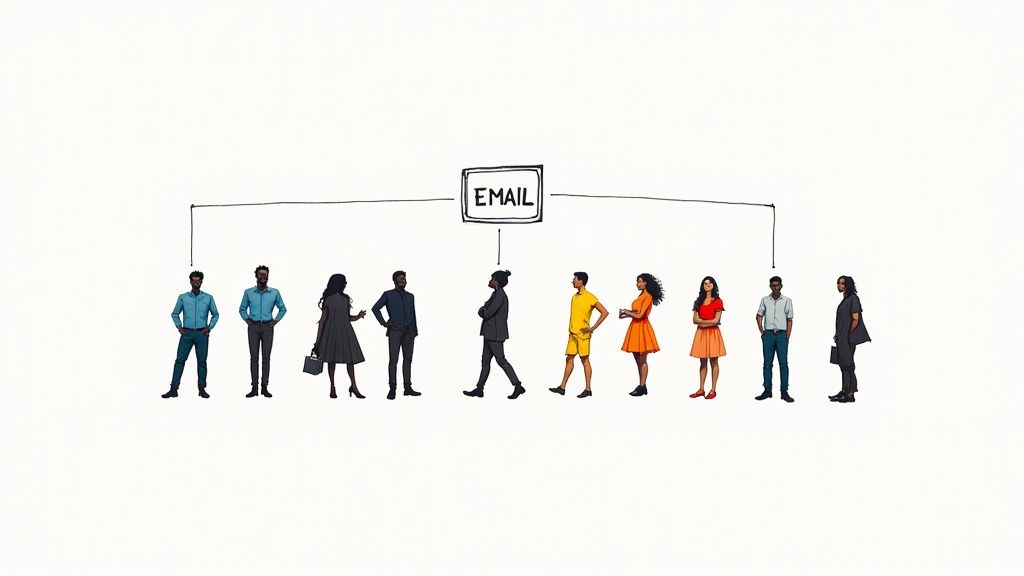
When you're building an ecommerce email marketing strategy, every conversation eventually lands on one crucial topic: return on investment (ROI). It's the metric that cuts through the creative chatter and gets everyone, from the marketing team to the CFO, speaking the same language. The numbers don't lie—email isn't just a dependable channel; it's an exceptionally profitable one.
Industry data consistently shows that for every $1 spent on email marketing, businesses see an average return of around $42. That's not a typo. This powerful return comes from nurturing direct relationships with an audience that has already opted in to hear from you. While it’s true that quality campaigns require effort—over 60% of marketers say they spend at least two weeks on a single email—the payoff is more than worth it. You can dive deeper into the data behind these figures in Shopify's latest report on email performance.
Budgeting for High Returns
So, where does email marketing fit in your overall budget? It's helpful to see how it stacks up against other common marketing channels.
Let's look at a quick comparison to see how email's efficiency and return potential compare to other popular marketing avenues for ecommerce brands.
Email Marketing ROI vs Other Marketing Channels
Comparison of average ROI and cost-effectiveness across different ecommerce marketing channels
| Marketing Channel | Average ROI | Typical Budget Allocation | Time to ROI |
|---|---|---|---|
| Email Marketing | Very High | Low to Medium | Short to Medium |
| Paid Search (PPC) | High | Medium to High | Short |
| Social Media Ads | Medium | Medium to High | Medium |
| Content Marketing | Medium to High | Low to Medium | Long |
As the table shows, email marketing occupies a sweet spot. It delivers impressive returns without needing the heavy financial investment often required for paid advertising like PPC or social media ads.
This efficiency is a huge advantage. It allows you to reinvest your profits into other growth areas, creating a sustainable cycle that fuels your business. A smart ecommerce email strategy isn't about outspending your competitors; it's about investing wisely in a channel you directly own and control.
Building Email Lists That Actually Want To Buy
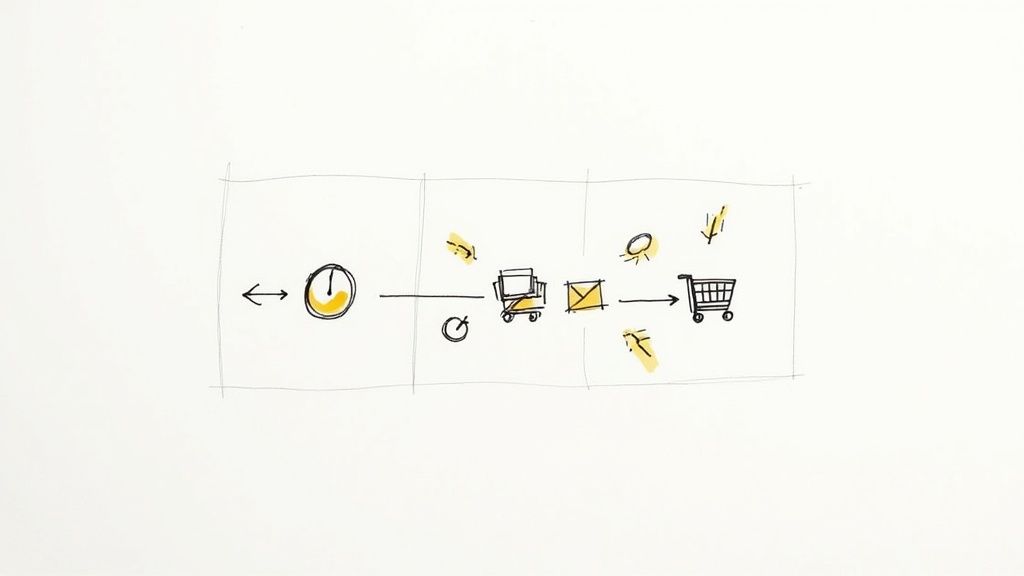 An effective ecommerce email marketing strategy starts long before you ever hit “send.” It all begins with how you build your list. Forget just slapping a generic “10% off” popup on your website. The real goal isn’t to collect as many emails as possible; it’s to bring in subscribers who are genuinely interested in what you sell and are excited to hear from you.
An effective ecommerce email marketing strategy starts long before you ever hit “send.” It all begins with how you build your list. Forget just slapping a generic “10% off” popup on your website. The real goal isn’t to collect as many emails as possible; it’s to bring in subscribers who are genuinely interested in what you sell and are excited to hear from you.
Think about it: a small, engaged list of 1,000 potential buyers is way more valuable than a list of 10,000 people who only signed up for a one-time discount and never open another message. Real list growth happens when you offer true value in exchange for that precious access to someone's inbox.
Creating Compelling Signup Opportunities
To attract high-quality subscribers, your opt-in incentive needs to connect with your brand's purpose. It's time to move beyond simple discounts and think about offering more meaningful exchanges.
- Content Upgrades: If you sell high-end kitchenware, why not offer a downloadable guide to a specific cooking technique that features your products? This brings in people who are passionate about cooking, not just chasing a deal.
- Early Access: For a clothing brand, give subscribers first dibs on new collections. This makes them feel like insiders and helps build a strong sense of community around your brand.
- Interactive Quizzes: A skincare company could create a "Find Your Perfect Routine" quiz. At the end, visitors enter their email to get personalized results and product recommendations.
This method ensures you’re attracting people who have a real interest in your specific niche.
Segmentation from Day One
Start sorting your subscribers the moment they sign up. You can do this by asking one simple, strategic question on your signup form. For example, a pet store could ask, "Are you a dog person or a cat person?" This small detail lets you send targeted content that actually resonates, helping you build a strong connection from the very first email and paving the way for future customer retention strategies for ecommerce.
Decoding How Your Customers Really Use Email
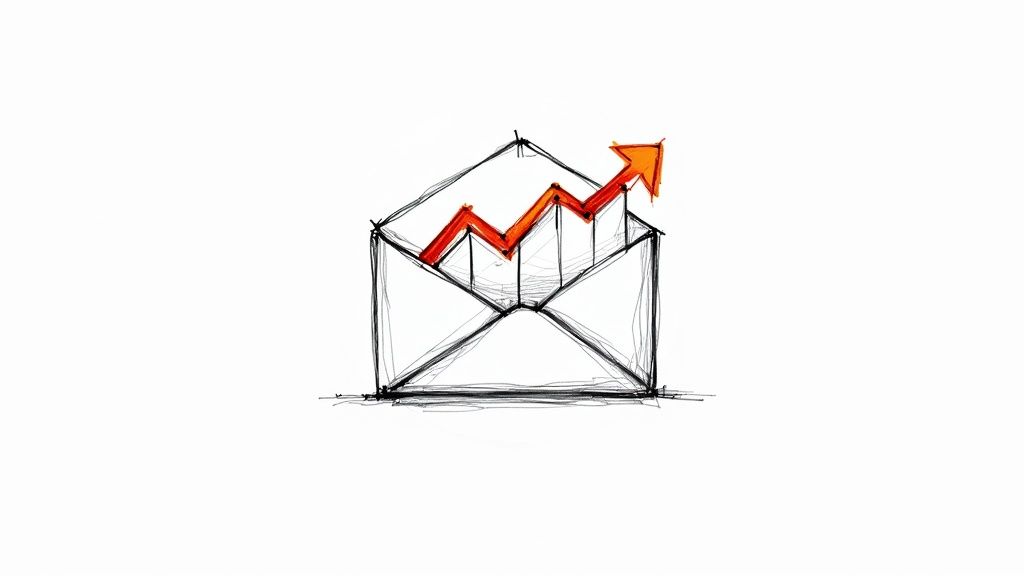
The assumptions you’re making about when and how customers read your emails could be quietly hurting your sales. A key part of a successful ecommerce email marketing strategy involves moving beyond old rules of thumb and observing actual customer behavior. That "Tuesday at 10 AM" send time isn't a universal solution. If you're a skincare brand targeting busy moms, an 8 PM email after the kids are asleep might land perfectly. For a B2B supplier, that classic Tuesday morning slot could still be the sweet spot.
Your approach needs to reflect how people genuinely interact with their inboxes today. This means understanding not just when they check email, but also where and on what device.
The Mobile-First Reality
These days, the inbox is almost always in someone's pocket. People check emails while waiting for coffee, during their commute, or even while watching TV. This on-the-go behavior has major consequences for your email design and content.
- Punchy Subject Lines: Keep them short and to the point. Long subject lines get cut off on phone screens, killing your open rate before it has a chance.
- Simple Email Design: A single-column layout is your best friend. Use large text and big, easy-to-tap buttons. No one enjoys the pinch-and-zoom dance.
- Visible Call-to-Action: Place your primary CTA near the top. If your customers have to scroll endlessly to find it, they probably won't.
Understanding Email Frequency and Engagement
Email is a constant companion for most people, not just a tool they check once a day. With 61% of users checking their email daily, and 41% of all emails being opened on mobile devices, you have plenty of opportunities to make a connection. In fact, 60% of consumers say they prefer receiving promotional messages through email over any other channel.
This high level of interaction shows that email is still a direct and effective line to your audience—but only if your strategy respects their real-world habits. You can dive deeper into how people use email with OptinMonster's data-driven report.
Writing Emails That Turn Browsers Into Buyers
The real art of an ecommerce email marketing strategy is writing messages that don't just get opened but actually convince someone to buy. The gap between an email that drives sales and one that gets deleted often comes down to a few key elements that go beyond a simple discount announcement. It’s all about creating genuine desire and building trust, one email at a time.
You have to find the right balance between promotion and value. A constant stream of "20% OFF!" emails will quickly wear out your audience. Instead, mix in content that genuinely helps them. If you sell apparel, you could send a style guide showing how to wear a new piece. For a cookware brand, a recipe featuring a best-selling pan is a great way to add value. This approach builds trust and positions your brand as a helpful expert, not just another retailer.
Before we dive deeper, let's look at the types of email campaigns that consistently perform well for ecommerce stores. The table below compares different campaigns, showing you where to focus your efforts for the best results.
| Campaign Type | Average Open Rate | Average Click Rate | Average Conversion Rate | Best Use Case |
|---|---|---|---|---|
| Welcome Series | 30-40% | 5-10% | 2-5% | Nurturing new subscribers and driving the first purchase. |
| Cart Abandonment | 40-45% | 8-12% | 8-10% | Recovering potentially lost sales from interested shoppers. |
| Post-Purchase Follow-up | 35-50% | 10-15% | 3-7% | Building loyalty, encouraging reviews, and promoting repeat buys. |
| Promotional/Sale | 20-30% | 3-7% | 1-3% | Driving immediate revenue and clearing inventory. |
| Win-Back Campaign | 15-25% | 2-5% | 1-2% | Re-engaging inactive customers before they churn. |
As you can see, transactional and behavior-based emails like cart abandonment and welcome series often outperform standard promotional blasts. This is because they're timely and directly relevant to the customer's recent actions, making them feel more personal and less like a generic ad.
Crafting a Compelling Narrative
Storytelling is one of the most powerful tools in your email marketing kit. People connect with stories on an emotional level, far more than they do with sterile product descriptions. Instead of just listing features, show your product in action through a customer’s experience or give a behind-the-scenes glimpse of how it’s made. This forges an emotional connection that facts and figures can't match.
Personalization also needs to go beyond just using a customer’s first name. You should use their on-site behavior to shape the content they receive.
- Dynamic Product Recommendations: If a customer bought running shoes, show them moisture-wicking socks or running shorts in their next email.
- Behavioral Triggers: Did someone browse your "New Arrivals" section three times this week? Send them an email highlighting the top sellers from that collection.
- Adaptive Content: The content you show a first-time buyer should be different from what you send a VIP customer. For example, you might offer the new customer a welcome discount while giving the VIP early access to a new collection.
By tailoring the experience, you make each person feel seen and understood. This level of detail is a crucial part of creating powerful ecommerce email flows that actually convert.
Finally, use urgency and scarcity with intention. Avoid creating fake pressure. Instead, tie it to real-world situations. Phrases like "Last chance for free holiday shipping" or "Only 5 left in your size" work because they’re based on genuine constraints. This approach motivates action without feeling manipulative, effectively turning a passive browser into an immediate buyer.
Automation That Works Around The Clock
The real magic of a strong ecommerce email marketing strategy happens when it starts generating revenue on autopilot. That's where automation comes in, working tirelessly to connect with your customers even when you're offline. Instead of sending one generic message to your entire list, automation delivers perfectly timed, relevant emails based on what a customer actually does. Think of it as the difference between a random flyer and a personal note from a helpful store clerk.
When done right, automation feels helpful, not robotic. The trick is to map out the typical customer journey and build workflows that respond to those key moments. For instance, a friendly welcome series for new subscribers can guide them toward their first purchase, while a thoughtful post-purchase follow-up can encourage a second sale and build some real loyalty.
Essential Automation Workflows
To get started, you don't need to automate everything. Focus on the automations that deliver the biggest impact by addressing common e-commerce situations. These are the workhorses of any solid email strategy:
- Welcome Series: This is your first impression, so make it count! A series of 3-5 emails can introduce your brand's story, highlight your best-selling products, and even offer a small incentive to seal that first deal.
- Abandoned Cart Recovery: It happens all the time: a customer adds an item to their cart but gets distracted. An automated email sent an hour later reminding them of what they left behind can recover a huge chunk of what would have been lost sales. Data shows these reminder emails have an average conversion rate of 8-10%.
- Win-Back Campaigns: For customers who haven't bought anything in a while, a friendly win-back campaign can bring them back into the fold. Try offering a special discount or showing them what's new since their last visit to rekindle their interest.
Many modern email platforms, like Mailchimp, offer visual builders to help you set up these kinds of automated customer journeys.
This visual style makes it easy to see how different emails connect based on customer actions, like opening an email or clicking a link. For a deeper dive into creating these powerful systems, you can learn more about marketing automation for ecommerce. By setting up these smart sequences, you build a system that consistently drives sales and deepens customer relationships, 24/7.
Tracking What Actually Drives Revenue Growth
It's tempting to get caught up in open rates, but a high open rate doesn't pay the bills. A truly effective ecommerce email marketing strategy looks past these surface-level numbers and zeroes in on metrics that directly signal business growth. The most successful brands are obsessed with figures like revenue per email (RPE) and improvements in customer lifetime value (CLV) that come from their email programs. These are the numbers that reveal what’s actually making an impact.
Think about it this way: an email that gets a 50% open rate but generates zero sales is actually a failure. On the flip side, an email with a 15% open rate that brings in thousands in revenue is a massive win. Your goal should be to make decisions based on profitability, not just engagement.
Beyond Basic A/B Testing
Once you start tracking the right numbers, you can run much more insightful tests. Forget about simply testing two different subject lines. A more advanced approach involves running experiments that can genuinely move the needle on your bottom line.
- Timing Experiments: Does sending an abandoned cart email at 8 PM on a weekday outperform sending it at 10 AM on a weekend? Run the test. The results might uncover surprising habits about your customers and when they're most likely to buy.
- Content Format Tests: Pit a long-form, story-driven email against a short, product-focused one. You might find that certain customer segments respond better to one style, allowing you to personalize future campaigns for better results.
- Audience Segmentation Trials: Send a "new arrivals" campaign to your entire list, but also send a specially curated version to your VIP customers. Compare the revenue generated per recipient to see if targeted sends are more profitable.
Spotting Performance Killers Early
Finally, you need a system for spotting trouble before it eats into your revenue. A sudden drop in deliverability or a design flaw that looks broken on a new phone can ruin an otherwise great campaign. Set up dashboards to monitor your key metrics week-over-week.
If your RPE or conversion rate from email takes an unexpected dip, treat it as an early warning sign. This gives you the chance to investigate and fix the problem right away, instead of waiting until the end of the month to realize you’ve lost sales.

